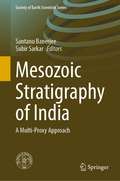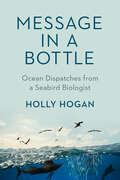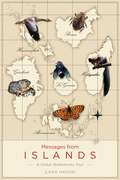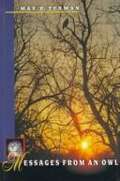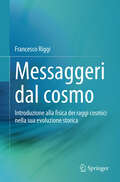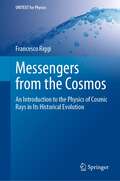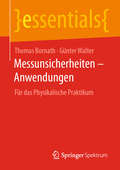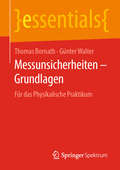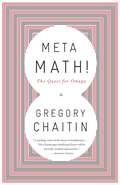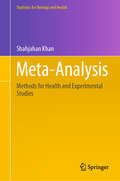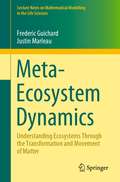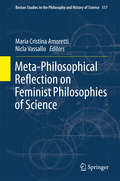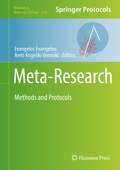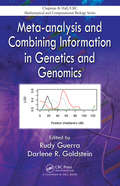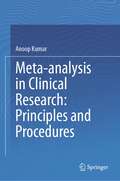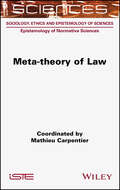- Table View
- List View
Mesoscopic Thermodynamics for Scientists and Engineers
by Mikhail A. Anisimov Thomas J. LongoProvides comprehensive coverage of the fundamentals of mesoscopic thermodynamics Mesoscopic Thermodynamics for Scientists and Engineers presents a unified conceptual approach to the core principles of equilibrium and nonequilibrium thermodynamics. Emphasizing the concept of universality at the mesoscale, this authoritative textbook provides the knowledge required for understanding and utilizing mesoscopic phenomena in a wide range of new and emerging technologies. Divided into two parts, Mesoscopic Thermodynamics for Scientists and Engineers opens with a concise summary of classical thermodynamics and nonequilibrium thermodynamics, followed by a detailed description of fluctuations and local (spatially-dependent) properties. Part II presents a universal approach to specific meso-heterogeneous systems, illustrated by numerous examples from experimental and computational studies that align with contemporary research and engineering practice. Bridges the gap between conventional courses in thermodynamics and real-world practiceProvides in-depth instruction on applying thermodynamics to current problems involving meso- and nano-heterogeneous systemsContains a wealth of examples of simple and complex fluids, polymers, liquid crystals, and supramolecular equilibrium and dissipative structuresIncludes practical exercises and references to textbooks, monographs, and journal articles in each chapter Mesoscopic Thermodynamics for Scientists and Engineers is an excellent textbook for advanced undergraduate and graduate students in physics, chemistry, and chemical, mechanical, and materials science engineering, as well as an invaluable reference for engineers and researchers engaged in soft-condensed matter physics and chemistry, nanoscience and nanotechnology, and mechanical, chemical, and biomolecular engineering.
Mesothelioma: From Research to Clinical Practice
by Emilio Bombardieri Giovanni Luca Ceresoli Maurizio D’IncalciThis book offers an updated review of malignant mesothelioma, including the latest advances in our understanding of its genetic control and molecular biology, as well as pre-clinical and clinical research. It also presents state-of-the-art diagnostic approaches and therapeutic options, and an open discussion on the future prospects for patient management. Malignant mesothelioma is an enormous global health problem related to asbestos exposure. Despite the best efforts of scientists and oncologists, the prognosis for those affected remains poor. Due to anatomical characteristics and non-specific symptoms, the diagnosis of mesothelioma at an early stage is often difficult, while surgery and radiotherapy are only of limited use, even if some multimodality approaches seem promising. In turn, medical treatments are sometimes successful in tumor control, but have little impact on overall survival. However, advances in our understanding of the disease’s biology, together with the availability of new drugs and combinations, make mesothelioma an essential and highly topical field for pre-clinical and clinical studies. This book is subdivided into four parts: epidemiology and preclinical data, diagnosis, therapy, and extrathoracic mesothelioma. It highlights the progress made in a variety of areas – e.g. in vitro and in vivo experimental models, genetics, environment, biomarkers, targeting agents, immunotherapy, metabolic imaging and ongoing clinical trials – and describes the standard clinical management of mesothelioma patients, including those with extra-thoracic localizations. Given its scope, the book offers an invaluable tool for researchers, oncologists and clinicians alike.
Mesotheliomas of Animals: A Comprehensive, Tabular Compendium of the World's Literature
by Edward B. IlgrenMesotheliomas of Animals is the first book to provide a comprehensive compilation of the diverse and often disparate literature regarding animal mesotheliomas. The compendium presents evidence to support the existence of "background" and "threshold," both of which are concepts central to the controversy surrounding nonasbestos-related mesotheliomas. Examples of "background" tumors (those which are nonasbestos-related) are described in detail, and indications of "threshold" for the induction of mesotheliomas following exposure to asbestiform and nonasbestiform agents are evident from the "positive dose-response" studies that are discussed. This compendium also allows for easy comparison of tumor yields elicited in "inoculation" studies performed with the same fiber types at similar doses. These comparisons often demonstrate markedly different tumor yields and highlight the limitations of injection techniques for fiber safety assessment. Mesotheliomas of Animals will be an essential reference for industrial hygienists, environmental lawyers, cancer researchers, and pulmonary scientists. It will be particularly useful to anyone involved with the design of fiber safety tests or with developing experimental models and protocols to assess the manner in which mesotheliomagenesis occurs.
Mesozoic Mammals from South America and Their Forerunners (Springer Earth System Sciences)
by Analía M. Forasiepi Guillermo W. Rougier Agustín G. MartinelliThis book summarizes the most relevant published paleontological information, supplemented by our own original work, on the record of Mesozoic mammals’ evolution, their close ancestors and their immediate descendants. Mammals evolved in a systematically diverse world, amidst a dynamic geography that is at the root of the 6,500 species living today. Fossils of Mesozoic mammals, while rare and often incomplete, are key to understanding how mammals have evolved over more than 200 million years. Mesozoic mammals and their close relatives occur in a few dozen localities from Argentina, Brazil, Chile, Bolivia, and Peru spanning from the Mid- Triassic to the Late Cretaceous, with some lineages surviving the cataclysmic end of the Cretaceous period, into the Cenozoic of Argentina. There are roughly 25 recognized mammalian species distributed in several distinctive lineages, including australosphenidans, multituberculates, gondwanatherians, eutriconodonts, amphilestids and dryolestoids, among others. With its focus on diversity, systematics, phylogeny, and their impact on the evolution of mammals, there is no similar book currently available.
Mesozoic Sea Dragons: Triassic Marine Life from the Ancient Tropical Lagoon of Monte San Giorgio (Life of the Past)
by Olivier RieppelAn extensive, illustrated study of the ancient fish and marine reptiles who once lived in a tropical lagoon that is now a Swiss mountain.Told in rich detail and with gorgeous color recreations, this is the story of marine life in the age before the dinosaurs. During the Middle Triassic Period (247–237 million years ago), the mountain of Monte San Giorgio in Switzerland was a tropical lagoon. Today, it is a UNESCO World Heritage Site because it boasts an astonishing fossil record of marine life from that time. Attracted to an incredibly diverse and well-preserved set of fossils, Swiss and Italian paleontologists have been excavating the mountain since 1850.Synthesizing and interpreting over a century of discoveries through a critical twenty-first century lens, paleontologist Olivier Rieppel tells for the first time the complete story of the fish and marine reptiles who made that long-ago lagoon their home. Through careful analysis and vividly rendered recreations, he offers memorable glimpses of not only what Thalattosaurs, Protorosaurs, Ichthyosaurs,Pachypleurosaurs, and other marine life looked like but how they moved and lived in the lagoon.An invaluable resource for specialists and accessible to all, this book is essential to all who are fascinated with ancient marine life.Praise for Mesozoic Sea Dragons“The most comprehensive review of the Middle Triassic marine faunas of Monte San Giorgio published to date. It synthesizes a vast body of literature in an accessible way and provides an informative, beautifully illustrated review of the vertebrate life that once thrived in the ancient lagoon. It also delivers a fascinating account of the history of fossil discoveries of this remarkable site.” —Palaeontologia Electronica
Mesozoic Stratigraphy of India: A Multi-Proxy Approach (Society of Earth Scientists Series)
by Santanu Banerjee Subir SarkarThis book envisages a multi-proxy approach using stable isotopes, geochemical proxies, magnetic susceptibility and associated biotic events for paleoclimatic and paleoenvironmental interpretations of the Mesozoic sedimentary record of India. Mesozoic rocks of India record abnormal sea level rise, greenhouse climate, intensified volcanism, hypoxia in seawater, extensive black shale deposition, and hydrocarbon occurrence. The Mesozoic has also witnessed mass extinction events, evolution of dinosaurs, and breakdown of the supercontinent Pangea and the formation of Gondwana. Although the Mesozoic geology of India has witnessed significant progress in the last century, literature survey reveals a huge gap in knowledge regarding sequence stratigraphy, chemostratigraphy and key geological events. A synthesis of sedimentological, paleontological and chemical data is included to presenting a comprehensive understanding of the Indian Mesozoic record to students, researchers and professionals.
Message in a Bottle: Ocean Dispatches from a Seabird Biologist
by Holly HoganFrom the heart of the Labrador Current to the furthest reaches of our global oceans, Message in a Bottle conjures an exquisite diversity of marine life and warns of a central threat to its survival: ocean plastic.The dovekie is a stocky seabird the size of a child&’s heart that spends its winters on the coast of Newfoundland, thriving in one of the toughest climates on Earth. The polar bear is an apex predator, designed to persevere in the Arctic's extreme conditions. The North Atlantic right whale outweighs the humpback by more than twenty tons and feeds on enormous quantities of tiny plankton in northeastern waters before migrating south for the winter. In Message in a Bottle, wildlife biologist and writer Holly Hogan brings to extraordinary life the wonder and resilience of these creatures and many other birds, fish and marine mammals she has encountered in sea voyages from the Arctic to the Antarctic oceans. However, in her travels she has noticed a troubling pattern: the constant presence of plastic, in the form of adrift fishing gear ("ghost gear"), garbage and micro-plastics which form an invisible but pervasive smog in our oceans and threaten even the most seemingly resilient forms of sea life.Bringing together nature, science and adventure writing, Hogan shines a light on our plastic-addicted lifestyle and offers a compelling, eyewitness account of its devastating effects on the marine environment—70% of our planet. With lyrical prose and a reverential eye for the majesty and fragility of our natural world, Message in a Bottle is a clarion call to protect global oceans and the life they sustain, including our own.
Messages from Islands: A Global Biodiversity Tour
by Ilkka HanskiFrom a small island in the Baltic Sea to the large tropical islands of Borneo and Madagascar, Messages from Islands is a global tour of these natural, water-bound laboratories. In this career-spanning work, Ilkka Hanski draws upon the many islands on which he performed fieldwork to convey key themes in ecology. By exploring the islands’ biodiversity as an introduction to general issues, Hanski helps us to learn how species and communities interact in fragmented landscapes, how evolution generates biodiversity, and how this biodiversity is maintained over time. Beginning each chapter on a particular island, Hanski dives into reflections on his own field studies before going on to pursue a variety of ecological questions, including: What is the biodiversity crisis? What are extinction thresholds and extinction debts? What can the biodiversity hypothesis tell us about rapidly increasing allergies, asthma, and other chronic inflammatory disorders? The world’s largest island, Greenland, for instance, is the starting point for a journey into the benefits that humankind acquires from biodiversity, including the staggering biodiversity of microbes in the ecosystems that are closest to us—the ecosystems in our guts, in our respiratory tracts, and under our skin. Conceptually oriented but grounded in an adventurous personal narrative, Messages from Islands is a landmark work that lifts the natural mysteries of islands from the sea, bringing to light the thrilling complexities and connections of ecosystems worldwide.
Messages from an Owl
by Max R. TermanFrom the Book Jacket: When zoologist Max Terman came to the rescue of a great horned owlet in the park of a small Kansas town, he embarked on an adventure that would test his scientific ingenuity and lead to unprecedented observations of an owl's hidden life in the wild. In Messages from an Owl, Terman not only relates his experiences nursing the starving owlet, "Stripey," back to health and teaching it survival skills in his barn, but he also describes the anxiety and elation of letting a companion loose into an uncertain world. Once Terman felt that Stripey knew how to dive after prey, he set the owl free. At this point his story could have ended, with no clue as to what the young bird's fate would be--had it not been for Terman's experimentation with radio tags. By strapping the tags to Stripey, the author actually managed to follow the owl into the wild and observe for himself the behavior of a hand-reared individual reunited with its natural environment. Through this unique use of telemetry, Terman tracked Stripey for over six years after the bird left the scientist's barn and took up residence in the surrounding countryside on the Kansas prairie. The radio beacon provided him with information on the owl's regular patterns of playing, hunting, exploring, and protecting. It enabled him to witness the moments when Stripey was bantered and mobbed by crows, when other owls launched fierce attacks, and when a prospective mate caught Stripey's eye. Stripey checked in occasionally with Terman back at the barn, following him around as he performed chores, usually waiting for a handout. Until now, scientists have generally believed that an owl nurtured by humans becomes ill-adapted for meeting the challenges of life in the wild. Terman's research proves otherwise. Stripey surpassed all expectations by becoming a totally independent wild creature. With Terman, however, Stripey remained tame, allowing the author to explore something one rarely sees in owls: a warm interest in humanity. Terman engagingly recreates this dimension of Stripey as he describes with humor and compassion the daily challenges of probing the life of a "phantom winged tiger."
Messaggeri dal cosmo: Introduzione alla fisica dei raggi cosmici nella sua evoluzione storica
by Francesco RiggiQuesto libro fornisce una panoramica completa dello sviluppo della fisica dei raggi cosmici, con considerazioni storiche e didattiche, dalle prime prove dell'esistenza della radiazione extraterrestre fino alle più recenti applicazioni dei muoni cosmici in diversi aspetti della vita quotidiana. Molti dei risultati originali che hanno contribuito allo studio della radiazione cosmica vengono presentati e discussi, accompagnati da oltre 500 riferimenti bibliografici, numerose appendici di approfondimento, circa 200 illustrazioni e un ampio capitolo dedicato all'impatto complessivo dei raggi cosmici. Il libro comprende varie sezioni, tra cui: il dibattito sulla natura corpuscolare o radiativa della radiazione cosmica; lo sviluppo delle prime tecniche di rivelazione della radiazione cosmica; le proprietà e la composizione della radiazione primaria e secondaria; l'influenza dell'ambiente terrestre e del Sole sul flusso dei raggi cosmici; l'interazione dei muoni cosmici nella materia e un lungo elenco delle loro recenti applicazioni, che vanno dalle tecniche di tomografia muonica allo studio della stabilità degli edifici civili. Questo volume intende soddisfare un vasto pubblico. Adatto per corsi introduttivi sulla fisica dei raggi cosmici a livello universitario, sia triennale che magistrale, si rivela altrettanto prezioso per studenti delle scuole superiori e insegnanti coinvolti in progetti didattici su questo argomento. Grazie alla ricchezza dei suoi contenuti storici e didattici, offre vantaggi tangibili a chiunque desideri approfondire la conoscenza dei raggi cosmici.
Messdatenauswertung im Physikalischen Praktikum: Messunsicherheit
by Thomas Bornath Günter WalterIn diesem Lehrbuch wird der Umgang mit Messdaten und ihren Unsicherheiten in knapper und anschaulicher Weise auf der Grundlage aktueller, international standardisierter Methoden (GUM: ISO/IEC 98-3:2008) dargestellt. Zum leichteren Verständnis wird der Leser in einem einleitenden Kapitel in die Grundlagen der Statistik und Wahrscheinlichkeitsrechnung mit Hilfe von anschaulichen Beispielen eingeführt. Es werden grundlegende Kenntnisse über das Wesen von Messabweichungen, über Messunsicherheit und Wahrscheinlichkeitsverteilung, die Bestimmung der kombinierten und erweiterten Messunsicherheit und über Ausgleichsrechnung vermittelt. Der Hauptteil des Buches ist auf die Auswertung von Messdaten zur unmittelbaren Anwendung im Physikalischen Praktikum gerichtet. Für die wesentlichen Typen von Messaufgaben findet der Leser eine Zusammenstellung aller nötigen Formeln zur Bestimmung des Bestwertes und der kombinierten und erweiterten Messunsicherheit sowie praktische Hinweise für die Ermittlung von Unsicherheiten nach Typ B (nichtstatistische Methode).Zahlreiche durchgerechnete Beispiele geben konkrete Anleitungen und demonstrieren, wie die Ergebnisse ins Praktikumsprotokoll eingehen und wie sie diskutiert werden.Das vorliegende Kompendium ist sowohl für Studierende in einem Bachelor- oder Lehramtsstudiengang Physik als auch für Studierende in natur- und ingenieurwissenschaftlichen Studiengängen mit Nebenfach Physik geeignet.
Messenger RNA Therapeutics (RNA Technologies #13)
by Jan Barciszewski Stefan JurgaThis book focuses on the fundamentals and applications of messenger RNA (mRNA)-based therapeutics and discusses the strengths and key challenges of this emerging class of drugs. In the past 30 years, extensive research and technological development in many areas have contributed to the emergence of in vitro transcribed mRNA as a therapeutic that has now reached clinical testing. Formulations that protect the mRNA from nucleases and accelerate its cellular uptake, combined with improvements to the mRNA molecules themselves, have been critical advancements for mRNAs to become viable therapeutics. Though once regarded as a serious impediment, the transient nature of mRNA technology is now considered a major advantage in making mRNA therapies safe and, ultimately, a potential game changer in the field of medicine. This new book in the RNA Technologies series provides a state-of-the-art overview on the emerging field of mRNA therapeutics covering essential strategies for formulation, delivery, and application. It also reviews the promising role in cancer immunotherapy, respiratory diseases, and chronic HBV infection and discusses RNA vaccines in light of the current COVID-19 pandemic. mRNA-based approaches have great potential to revolutionize molecular biology, cell biology, biomedical research, and medicine. Thus, this handbook is an essential resource for researchers in academia and industry contributing to the development of this new area of therapeutics.
Messengers from the Cosmos: An Introduction to the Physics of Cosmic Rays in Its Historical Evolution (UNITEXT for Physics)
by Francesco RiggiThis book provides a complete overview of the development of cosmic ray physics, with historical and educational considerations, from early evidence of the existence of extraterrestrial radiation up to the most recent applications of cosmic ray muons in different aspects of daily life.Many of the original results that contributed to the study of cosmic radiation are presented and discussed, accompanied by bibliographic references, numerous in-depth appendices, about 200 illustrations and a large chapter dedicated to the overall impact of cosmic rays.The book includes sections on, among other topics: the debate on the corpuscular or radiative nature of cosmic radiation; the development of early techniques for detecting cosmic particles; the properties and composition of primary and secondary radiation; and the interaction of cosmic muons in matter and a long list of their recent applications, ranging from the muon tomography techniques to the investigation of the stability of civil buildings. The book is addressed to a wide audience, and thus, while it is used for introductory cosmic ray physics courses at the bachelor's or master's level, high school students and teachers involved in educational projects around cosmic rays also benefit from its many historical and educational aspects.
Messunsicherheiten – Anwendungen: Für das Physikalische Praktikum (essentials)
by Thomas Bornath Günter WalterIn diesem Buch wird die Auswertung von Messdaten mit ihren Unsicherheiten für die Anwendung im Physikalischen Praktikum dargestellt. Für die wesentlichen Typen von Messaufgaben findet der Leser eine Zusammenstellung aller nötigen Formeln zur Bestimmung des Bestwertes und der kombinierten und erweiterten Messunsicherheit sowie praktische Hinweise für die Ermittlung von Unsicherheiten nach Typ B (nichtstatistische Methode). Zahlreiche durchgerechnete Beispiele geben konkrete Anleitungen und demonstrieren, wie die Ergebnisse ins Praktikumsprotokoll eingehen und wie sie diskutiert werden. Das vorliegende Kompendium ist sowohl für Studierende in einem Bachelor- oder Lehramtsstudiengang Physik als auch für Studierende in natur- und ingenieurwissenschaftlichen Studiengängen mit Nebenfach Physik geeignet.
Messunsicherheiten – Grundlagen: Für das Physikalische Praktikum (essentials)
by Thomas Bornath Günter WalterIn diesem Buch wird der Umgang mit Messdaten und ihren Unsicherheiten in knapper und anschaulicher Weise dargestellt. Im „Leitfaden zur Angabe der Unsicherheit beim Messen“ (ISO/IEC 98-3:2008) sind die Terminologie und die Methoden für die Behandlung von Messunsicherheiten international standardisiert. Auf dieser Grundlage werden dem Leser Kenntnisse über das Wesen von Messabweichungen, über Messunsicherheit und Wahrscheinlichkeitsverteilung, die Bestimmung der kombinierten und erweiterten Messunsicherheit und über Ausgleichsrechnung vermittelt.Das vorliegende Kompendium ist sowohl für Studierende in einem Bachelor- oder Lehramtsstudiengang Physik als auch für Studierende in natur- und ingenieurwissenschaftlichen Studiengängen mit Nebenfach Physik geeignet.
Mestizo Genomics: Race Mixture, Nation, and Science in Latin America
by Carlos López López Beltrán Peter Wade Ricardo Ventura Santos Eduardo RestrepoIn genetics laboratories in Latin America, scientists have been mapping the genomes of local populations, seeking to locate the genetic basis of complex diseases and to trace population histories. As part of their work, geneticists often calculate the European, African, and Amerindian genetic ancestry of populations. Some researchers explicitly connect their findings to questions of national identity and racial and ethnic difference, bringing their research to bear on issues of politics and identity.Drawing on ethnographic research in Brazil, Colombia, and Mexico, the contributors to Mestizo Genomics explore how the concepts of race, ethnicity, nation, and gender enter into and are affected by genomic research. In Latin America, national identities are often based on ideas about mestizaje (race mixture), rather than racial division. Since mestizaje is said to involve relations between European men and indigenous or African women, gender is a key factor in Latin American genomics and in the analyses in this book. Also important are links between contemporary genomics and recent moves toward official multiculturalism in Brazil, Colombia, and Mexico. One of the first studies of its kind, Mestizo Genomics sheds new light on the interrelations between "race," identity, and genomics in Latin America.Contributors. Adriana Díaz del Castillo H., Roosbelinda Cárdenas, Vivette García Deister, Verlan Valle Gaspar Neto, Michael Kent, Carlos López Beltrán, María Fernanda Olarte Sierra, Eduardo Restrepo, Mariana Rios Sandoval, Ernesto Schwartz-Marín, Ricardo Ventura Santos, Peter Wade
Meta Math!: The Quest for Omega
by Gregory ChaitinIn Meta Math!, Gregory Chaitin, one of the world’s foremost mathematicians, leads us on a spellbinding journey of scientific discovery and illuminates the process by which he arrived at his groundbreaking theories. All of science is based on mathematics, but mathematicians have become painfully aware that math itself has serious limitations. This notion was first revealed in the work of two giants of twentieth-century mathematics: Kurt Gödel and Alan Turing. Now their successor, Gregory Chaitin, digs even deeper into the foundations of mathematics, demonstrating that mathematics is riddled with randomness, enigmas, and paradoxes. Chaitin’s revolutionary discovery, the Omega number, is an exquisitely complex representation of unknowability in mathematics. His investigations shed light on what, ultimately, we can know about the universe and the very nature of life. But if unknowability is at the core of Chaitin’s theories, the great gift of his book is its completely engaging knowability. In an infectious and enthusiastic narrative, Chaitin introduces us to his passion for mathematics at its deepest and most philosophical level, and delineates the specific intellectual and intuitive steps he took toward the discovery of Omega. In the final analysis, he shows us that mathematics is as much art as logic, as much experimental science as pure reasoning. And by the end, he has helped us to see and appreciate the art––and the sheer beauty––in the science of math. In Meta Math!, Gregory Chaitin takes us to the very frontiers of scientific thinking. It is a thrilling ride. From the Hardcover edition.
Meta-Analysis: Methods for Health and Experimental Studies (Statistics for Biology and Health)
by Shahjahan KhanThis book focuses on performing hands-on meta-analysis using MetaXL, a free add-on to MS Excel. The illustrative examples are taken mainly from medical and health sciences studies, but the generic methods can be used to perform meta-analysis on data from any other discipline. The book adopts a step-by-step approach to perform meta-analyses and interpret the results. Stata codes for meta-analyses are also provided. All popularly used meta-analytic methods and models – such as the fixed effect model, random effects model, inverse variance heterogeneity model, and quality effect model – are used to find the confidence interval for the effect size measure of independent primary studies and the pooled study. In addition to the commonly used meta-analytic methods for various effect size measures, the book includes special topics such as meta-regression, dose-response meta-analysis, and publication bias. The main attraction for readers is the book’s simplicity and straightforwardness in conducting actual meta-analysis using MetaXL. Researchers would easily find everything on meta-analysis of any particular effect size in one specific chapter once they could determine the underlying effect measure. Readers will be able to see the results under different models and also will be able to select the correct model to obtain accurate results.
Meta-Ecosystem Dynamics: Understanding Ecosystems Through the Transformation and Movement of Matter (Lecture Notes on Mathematical Modelling in the Life Sciences)
by Frederic Guichard Justin MarleauThis book presents current meta-ecosystem models and their derivation from classical ecosystem and metapopulation theories. Specifically, it reviews recent modelling efforts that have emphasized the role of nonlinear dynamics on spatial and food web networks, and which have cast their implications within the context of spatial synchrony and ecological stoichiometry. It suggests that these recent advances naturally lead to a generalization of meta-ecosystem theories to spatial fluxes of matter that have both a trophic and non-trophic impact on species. Ecosystem dynamics refers to the cycling of matter and energy across ecological compartments through processes such as consumption and recycling. Spatial dynamics established its ecological roots with metapopulation theories and focuses on scaling up local ecological processes through the limited movement of individuals and matter. Over the last 15 years, theories integrating ecosystem and spatial dynamics have quickly coalesced into meta-ecosystem theories, the focus of this book. The book will be of interest to graduate students and researchers who wish to learn more about the synthesis of ecosystem and spatial dynamics, which form the foundation of the theory of meta-ecosystems.
Meta-Geopolitics of Outer Space
by Nayef R. F. Al-RodhanAl-Rodhan sheds new light on the debate about the geopolitics of outer space, going beyond applying traditional International Relations approaches to space power and security by introducing a multidimensional spatial framework. The meta-geopolitics framework includes space and expands classical power considerations to cover seven state capacities.
Meta-Philosophical Reflection on Feminist Philosophies of Science
by Maria Cristina Amoretti Nicla VassalloThis volume offers a meta-philosophical reflection on feminist philosophies of science. It emphasizes and discusses both the connections and differences between "traditional" philosophies of science and feminist philosophies of science. The collection systematically analyses feminist contributions to the various philosophies of specific sciences. Each chapter is devoted to a specific area of philosophy of science: general philosophy of science, philosophy of biology, philosophy of climate sciences, philosophy of cognitive sciences and neurosciences, philosophy of economics, philosophy of history and archaeology, philosophy of logic and mathematics, philosophy of medicine, philosophy of psychology, philosophy of physics, and philosophy of social sciences. Since some of these areas have so far rarely been addressed by feminist philosophers, this new collection provides new angels and stimulates the debate on pivotal issues that are part and parcel of both "traditional" philosophies of science and feminist philosophies of science. Using a range of different methodologies and styles, the essays all show great clarity in both arguments and contents.
Meta-Research: Methods and Protocols (Methods in Molecular Biology #2345)
by Evangelos Evangelou Areti Angeliki VeronikiThis volume presents state-of-the art design, analysis and integration approaches for biomedical data including novel statistical models for a comprehensive and powerful synthesis and assessment of scientific evidence. Chapters detail principles of systematic reviews, semi-automated tools for systematic searches, fixed- and random-effects meta-analytical models, living systematic reviews, meta-analysis of genetic studies, meta-analysis of pragmatic and explanatory trials, network meta-analysis, and other modern approaches for data synthesis. Written in the highly successful Methods in Molecular Biology series format, chapters include introductions to their respective topics, lists of the necessary materials, and tips on troubleshooting and avoiding known pitfalls. Authoritative and cutting-edge, the Meta- Research: Methods and Protocols book, written by global experts, will introduce the reader in a step-by-step process to the methods of the vital and highly promising field of evidence synthesis.
Meta-analysis and Combining Information in Genetics and Genomics (Chapman & Hall/CRC Computational Biology Series)
by Rudy Guerra Darlene R. GoldsteinNovel Techniques for Analyzing and Combining Data from Modern Biological StudiesBroadens the Traditional Definition of Meta-AnalysisWith the diversity of data and meta-data now available, there is increased interest in analyzing multiple studies beyond statistical approaches of formal meta-analysis. Covering an extensive range of quantitative infor
Meta-analysis in Clinical Research: Principles and Procedures
by Anoop KumarThis book provides conceptual information on the various processes involved in meta-analysis. It examines the importance of meta-analysis for the analyses of clinical data to draw a valid conclusion using suitable software. The initial sections of the book introduce meta-analysis, how to perform a systematic literature review (SLR), quality assessment of studies, extraction, and analysis of data. The subsequent section of the book contains information on advanced topics including, meta-regression, network meta-analysis, issues, mistakes, and future perspectives. In summary, the book provides a statistical method for combining the results of different studies on the same topic and resolving conflicts among studies. This book is written with the intent to allow a wide range of readers including students, researchers, and health care professionals, including physicians, nurses, pharmacists, and paramedical, and is also helpful for a beginner who would like to do a meta-analysis.
Meta-theory of Law
by Mathieu CarpentierThis book is devoted to the theory of legal theory, also referred to as the "meta-theory of law".The aim of this emerging discipline is to determine the objectives, aims and methods of legal theory, and to establish the conditions of possibility as well as the validity criteria for theoretical discourse on law. The contributions in this book provide an overview of these aspects through different perspectives and approaches.The very purpose of legal theory has been disputed and the subject area is currently subject to increasing cross-fertilization between different, and sometimes diverging, traditions. Meta-theory of Law assesses these emerging trends by questioning two basic objects of legal theory, the "nature" and the "science" of law.





